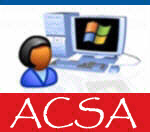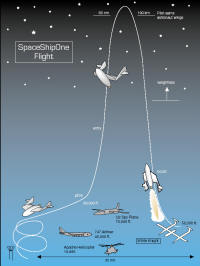|
||||||||||||
|
ACSA
Chairperson's politely critical opinion of Rutan and Branson Space
Flight designs. by Debbie Maher, ACSA Advances Magazine, January 22, 2008
-- Playfully Invites Burt Rutan and Lord
Branson to join "the real Space Age" "To put it mildly, Rutan,
Branson and Allen have an overblown sense of their own accomplishment.
Yes, it's a wonderful thing. No, it's not really space flight. I have
a feeling many of the 170 celebs who've signed on for a flight, do
not realize we're talking about a 5 minute weightless glide in total
darkness with a 160 mile round trip under extremely rough rocket boost
power on the way up and on feather braked stomach on the ceiling
glider action on the way down. What that makes it is the
rocket powered equal of a Steel Pier Amusement Park Ride. This is not about John Glenn making a dozen orbits of the
earth as a Senior Citizen Shuttle Passenger, taking photos and
landing. Despite the magnificence of what they have achieved at
Virgin Galactic, incredible in the scale of corporate sponsorship
private enterprise, it's far less a space race there and more of a
flying grasshopper match, or like a frog leaping between lily
pads... to coin a phrase."
"To begin with, the resemblance and design of Space Ship One to the original Air Force Bell X1 is quite apparent if you look closely, and it doesn't stop there. Resemblance of Space Ship Two to the NASA X15 Rocket Plane, is by any leap of the imagination, impressive. Yet, aside from the 'feather' braking system and fuels/engines in use, and the limited electronics design (more like basic Avionics Computers than Space Control Systems), however innovative (today, the Space Shuttle uses a 'braking maneuver' to achieve the same thing, as in its weight class a 'feather' such as Burt uses would likely shear right off), these steps in progress are not on a par with vehicles like the Shuttle or the B-2 Bomber or the Rocketry used by the Russians and Americans or newer Trans-Atmospheric Technologies. The two Rutan Space Craft designed for Virgin Galactic do not represent major leaps in technology however innovative they may be. In fact, they represent short cuts in technology, literally rocket powered high altitude X15 and X1 type aircraft which have the ability to leap like rapidly propelled fish out of water, up and just beyond the uppermost atmosphere only to fall back and need something to slow them down, hence the feather, which is revolutionary in that it need not use fuel to slow the craft like a de-orbit burn engine such as the OMS engines on the Shuttle. However, from there they go essentially no where but down. Nonetheless, to break into the "real space race" they need more than the feather brake: which would mean larger, more energetic propulsion systems, lots more weight and payloads that were worth the trip."
"The weight to power ratio
necessary to leap like a fish out of the water and fall back into
the atmosphere is miniscule by comparison to a long range shot at
the moon or even a long term orbiter, even versus any vehicle which
must carry a significant payload, and even less so for any craft
which would be used for sight seeing around the galaxy or solar
system ala Star Trek. Once in the vacuum of space, the
so-called 'feather' becomes a vestige of airborne flight,
essentially incapable of slowing a vehicle, thus requiring a
de-orbit burn thrust system of sufficient rocket propulsion power to
weight ratio to achieve a controlled de-orbit burn and reentry into
Earth's Atmosphere. There is no air to feather in empty space,
once in Orbit. There exists another problem, that being to
achieve orbit, the speed you then need to re-enter the atmosphere is
so high, one has to have special heat shielding to absorb it or you
can burn up in the Atmosphere even after braking. And one bad
mistake, you burn up anyway, as in Discovery's case."
"Let's face it: what we have here is a moving reproduction of test flights engaged in by the Air Force and young NASA when technology for space flight was very young, and the thought of a 'Space Plane' approach was still being entertained. Remarkable: yes, Revolutionary Space Flight Approach: no." "After analysis of needs, NASA rapidly returned to the ICBM design, the Saturn C-5 series booster rockets, in attempting to tackle a trip to the moon, staged payloads and micro-light materials for the LEM Lunar Lander. It wasn't until decades later, in the 70's, that the Space Shuttle plus Solid Rocket Booster plus Hydrogen fuel tank was adopted to handle the power to weight ratio needs of boosting significant payloads into orbit so that larger craft could be built once there, along with space stations and space telescopes and other satellites. When you go into space, "real space" as in orbital or super orbital flight: you have to take 'oodles' of Air, Water, Fuel, Food, and supplies. You need backup computers and a heck of a repair toolkit, patching materials, anti-G slings, safety equipment, space suits... the list is endless, plus a craft of sufficient size, propulsion and fuel to take you there and get you back." "This can not be sacrificed on
longer space flights, flights longer than a few seconds at the very
top of the Atmosphere. Accordingly, however magnificent the
gesture of having light duty sub-orbital space craft may be, they
are steps into the past, updating technology that can accomplish
little more than what was accomplished 50-60 years ago.
Capture the imagination? Yes. Achieve orbital and super
orbital Space Flight with them? No. Produce a commercial
return for Virgin? I doubt it. Once the roller coaster
ride like novelty wore off, the commercial flights based on any
design to date would likely be rapidly scrapped." "If Branson is serious about
eventually reaching Galactic Exploration status with his vehicles,
he should START with this, so that he can leverage Orbital Flight
for longer and longer term Tourism, and long super-orbital hops
between one side of the planet and the other, selling seats to those
who want to travel from Arizona to India in 1 hour or less, by by a
Virgin Galactic Trans Atmospheric Orbiter (TAO). Everything done to
date has been the 'play it safe' approach of limiting their
activities to reproducing the programs of the X1/X2 and x15. To my
knowledge, there is no TAO on the drawing boards at this time.
There should be, and yes, Mr. Rutan, I do know exactly how much
money, risk, engineering and development that will take!" Dr. Shulman indicated he had no criticism for the actual designs and was considering offering a $10,000,000 prize for accomplishment of 8 full, mid-altitude Orbits of the Earth in a privately designed and built space craft, along with a landing at a designated port 1/2 way around the world, with 10 passengers: as an ACSA Prize in the near future. "This would require developing an actual transport vehicle capable of full Orbital Flight, a full enough passenger capacity, and safe, reasonable landing ability, leading to a real commercial value for the future - both for putting things in Orbit and for using Orbital Flight to beat the pants off that wonderful Concorde... But maybe $10 million is not enough of a prize for that..." Shulman added. "Or, maybe it is..." --- |
||||||||||||




